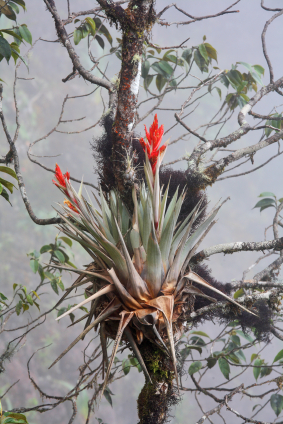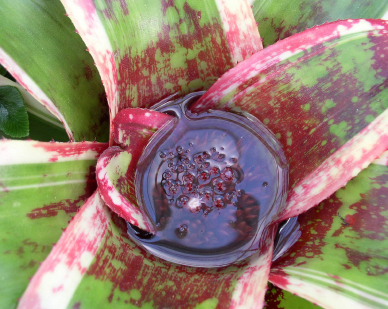The Ultimate Bromeliad Guide to Hohenbergia
Author: Celeste Booth3 Comments
Care and Culture, Classification
Hohenbergia is a genus of bromeliad that is made up of about 52 species. It is closely related to Achmea and some scientist argue that they should be included within that genus. Hohenbergia are native to Jamaica and other tropical islands as well as parts of South America, particularly Brazil and Venezuela. In Brazil, they are primarily found in the sandy and arid northern coasts. Species in the genus can range in habitat from sandy, dry areas to humid cloud forests.
Appearance
Hohenbergia are beautiful flowering bromeliads with very attractive foliage. They can grow quite large and typically have broad strap like leaves that are stiff and leathery. Some Hohenbergia remain upright, while others have leaves that bow out at the ends. The leaves often come together to form a tight rosette shape. Hohenbergia usually produce tall flower spike. Their flower spike is what distinguishes them from their close relatives in the Achmea genus. Achmeas produce a tall flower spike that is not branched while the inflorescence of the Hohenbergia is often branched with small clusters of flowers.
Growth Habit

Like this bromeliad, the Hohenbergia doesn’t need to grow on the ground.
Hohenbergia can be epiphytic plants, meaning they grow attached to a substrate rather than planted in the ground. The rosette shape of the leaves form a large central tank that collects rainwater and other nutrients that fall from the canopy. Special scales on the leaves take in the water and the nutrients, while the roots act as anchors. Although Hohenbergia are often found as epiphytes in nature, they can also be planted terrestrially. There are also Hohenbergia found growing terrestrially in very sandy or rocky soils. Some Hohenbergia, both terrestrial and epiphytic are very attractive grown in containers.
Potting Medium
Be sure to use a very well draining potting mix. Mixes that are specially crafted for bromeliads or orchids are ideal. You can also create your own potting medium using potting mix, perlite, and coarse sand. Never use garden soil because it is too dense and will not drain fast enough. When the potting soil remains too soggy it will encourage root rot and crown rot.
Light and Water Requirements

Be sure to rinse our the tank of your bromeliad.
Many Hohenbergia, especially those native to sandy beaches and coasts prefer full sun. There are some that thrive better in indirect light or dappled shade. Hohenbergia should be watered in their central tank. However, be careful not to allow the water to stagnate. Rinse the tank out regularly and use distilled or rain water to avoid mineral build up on the leaves.
Flowering
Like most other bromeliads Hohenbergia produce only a single inflorescence. The inflorescence is very long lasting, up to several months in some cases, but once it dies the plant will begin to die as well. However, Hohenbergia generously set on offshoots called pups. These offshoots can be removed and replanted or allowed to remain with mother plant as a clump. It can take some Hohenbergia as long as 5 years to reach maturity and produce a flower.
Species
There are not many varieties of Hohenbergia found in cultivation. Their close relatives Achmea are much more popular. Many species are difficult to grow because of their large size. However, a few species and cultivars of Hohenbergia can be found from specialty bromeliads retailers.
Hohenbergia stallata is a common Hohenbergia found in cultivation. It can make an excellent landscape plant in warm, tropical climates. It can be planted in containers indoors or outdoors during the summer in mild climates. The plant has broad, flat, bright green leaves that bend outwards. Its most stunning characteristic is its inflorescence. It sends up a tall flower stalk with bright salmon colored star shaped inflorescence. The blooms are long lasting and mature to a deeper red color. This plant can grow up to three feet tall and two feet wide. It prefers shade or dappled shade.
Hohenbergia ‘Chocolate Fudge’ is a beautiful cultivar. It has rich chocolate colored leaves with gray horizontal banding. Its leaves stand mostly erect and grow to about two feet tall. The flower stalk is a bright red with clusters of white, fuzzy looking inflorescence that shoot off on branches. This plant requires partial shade and makes an excellent container plant.
Hohenbergia castellanosii has very broad leaves that begin as bright green, but blush bright red from the tips inward when flowering. It grows up to 28 inches tall and 18 inches wide. The flower stalk is green and rather inconspicuous. This plant is grown for its stunning foliage. It does best outside in direct sunlight.
Hohenbergia leopoldo-horstii has a very beautiful shape and form. Its wide leaves taper off to a distinctive point at the tip. It is a smaller Hohenbergia that forms a very tight tube shaped rosette. When grown in full sun the leaves become a lovely purplish black color. The more sun the plant gets the darker the leaves will be. If the plant gets too much fertilizer or not enough light, it will remain entirely green.
Hohenbergia salzmanni is not grown in cultivation due to its massive size. In a Bromeliad Society Bulletin Mulfred Foster mentions encountering this giant on a trip to the state of Bahia in Brazil in 1939. He found it growing on the sandy beaches of the coast. Foster noted that the very stiff upright leaves were individually eight to ten inches wide and up to four feet long. It produced a thinly branched inflorescence that was up to eight feet tall with very small purple flowers.
Hohenbergia rosea is a large plant that can grow up to three feet tall and wide. It can tolerate shade to full sun. Its leaf coloring will depend on how much direct light it gets. In full sun the leaves will become a darker burgundy. In the shade the leaves will have a mottled green and purple appearance. The leaves are stiff and broad with sharp spines all the way around the margins. The plant produces a tall flower spike with pink egg shaped inflorescence and purple flowers.
Adding to Your Collection
Some Hohenbergia can be difficult to grow indoors due to their size, but they can thrive easily in landscapes in tropical climates. A rare and unique Hohenbergia would be an attractive addition to an outdoor landscape. They will grow to fill out a large space and pup generously creating large clumps of beautiful plants.
If you would like to grow a Hohenbergia in a container or indoors choose a species that grows to a more manageable size.
It can be difficult to find Hohenbergia for sale but some online specialty retailers have pups or seeds available. They can also be found in shows or special collections. If you have grown an Aechmea they behave very similarly and will not be difficult to grow. Consider expanding your collection to include a charming Hohenbergia. Have you grown a Hohenbergia? Where did you find it?
Sources
“Hohenbergia stellata.” Bullis Bromeliads.
“Hohenbergia ‘Fudge Ripple’.” Bullis Bromeliads.
“Hohenbergia Castellanosii.” Bullis Bromeliads.
“Hohenbergia stellata.” National Tropical Botanical Garden.
Foster, Mulfred B. “Hohenbergia in Horticulture.” The Bromeliad Society Bulletin. Vol. VI No. 4
“Honhenbergia leopoldo-horstii.” TJ Bromeliads.
“PlantFiles:Bromeliad”Dave’s Garden.
3 Responses to “The Ultimate Bromeliad Guide to Hohenbergia”
Leave a Reply

Resource Download
Hechtia Care Cheat Sheet
Learn how to care for your Hechtia bromeliad with this quick and easy informational guide.
Learn More
Ask an Expert
Questions about bromeliads?
Our experts love a challenge!
Photo of the Week
Submit your photo to be featured on the blog!
More Photo of the Week Winners
Submit Photo








I have started collecting the hohenbergia and would welcome any information/sources to expand my array. just love the hoh’s
PS my e-mail address is lower case
I have seven or eight of them – where do you live?
I have H. correia-araujoi. It doesn’t seem to thrive by a window with a lot of sun. Currently it’s planted in a pot but I’d like expert opinion on the best way to care for it. I have a nice big humid vivariums but scale killed off all the broms in it about 7 months ago so I’m resisting the urge to mount it in there. Any advice would be really appreciated! I’m happy to return the favor with a pup when I finally succeed with it. (Had it about a year, so at least it’s not dead…)